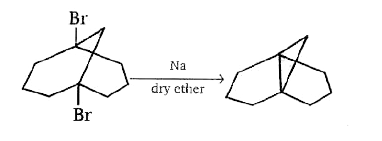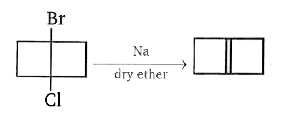Which of the following does not represent redox reaction?
Cr2O2−7+2ɵOH→CrO2−4+H2O
SO2−5+2Iɵ+2H⊕→I2+SO2−4
2Ca(OH)2+2Cl2→Ca(ClO)2+CaCl2+2H2O
PCl5→PCl3+Cl2
The correct Answer is:A
To determine which of the given reactions does not represent a redox reaction, we need to analyze each option based on the concept of oxidation and reduction. A redox reaction involves the transfer of electrons between species, leading to changes in their oxidation states.
1. Understand Redox Reactions:
- Redox reactions involve oxidation (increase in oxidation state) and reduction (decrease in oxidation state) occurring simultaneously.
- Identify the oxidation states of the elements in the reactants and products.
2. Analyze the First Reaction:
- Reaction: Chromate reaction.
- Oxidation states:
- Chromate (Cr) is in +6 oxidation state on both sides.
- Oxygen is consistently in -2, and hydrogen is in +1.
- Conclusion: No change in oxidation states means this is not a redox reaction.
3. Analyze the Second Reaction:
- Reaction: Iodine and sulfur reaction.
- Oxidation states:
- Iodine changes from -1 to 0 (oxidation).
- Sulfur changes from +8 to +6 (reduction).
- Conclusion: Both oxidation and reduction occur, so this is a redox reaction.
4. Analyze the Third Reaction:
- Reaction: Calcium hydroxide and chlorine reaction.
- Oxidation states:
- Chlorine changes from 0 to -1 (reduction).
- Chlorine also has a +1 state in the product.
- Conclusion: Both oxidation and reduction occur, so this is a redox reaction.
5. Analyze the Fourth Reaction:
- Reaction: PCl5 to PCl3 and Cl2.
- Oxidation states:
- Chlorine changes from -1 to 0 (oxidation).
- Phosphorus changes from +5 to +3 (reduction).
- Conclusion: Both oxidation and reduction occur, so this is a redox reaction.
6. Final Conclusion:
- The first reaction (chromate reaction) does not involve any change in oxidation states, hence it is not a redox reaction. The other three reactions involve changes in oxidation states, confirming they are redox reactions.
Answer:
The reaction that does not represent a redox reaction is the first option (chromate reaction).
---
- Redox reactions involve oxidation (increase in oxidation state) and reduction (decrease in oxidation state) occurring simultaneously.
- Identify the oxidation states of the elements in the reactants and products.
- Reaction: Chromate reaction.
- Oxidation states:
- Chromate (Cr) is in +6 oxidation state on both sides.
- Oxygen is consistently in -2, and hydrogen is in +1.
- Conclusion: No change in oxidation states means this is not a redox reaction.
- Reaction: Iodine and sulfur reaction.
- Oxidation states:
- Iodine changes from -1 to 0 (oxidation).
- Sulfur changes from +8 to +6 (reduction).
- Conclusion: Both oxidation and reduction occur, so this is a redox reaction.
- Reaction: Calcium hydroxide and chlorine reaction.
- Oxidation states:
- Chlorine changes from 0 to -1 (reduction).
- Chlorine also has a +1 state in the product.
- Conclusion: Both oxidation and reduction occur, so this is a redox reaction.
- Reaction: PCl5 to PCl3 and Cl2.
- Oxidation states:
- Chlorine changes from -1 to 0 (oxidation).
- Phosphorus changes from +5 to +3 (reduction).
- Conclusion: Both oxidation and reduction occur, so this is a redox reaction.
- The first reaction (chromate reaction) does not involve any change in oxidation states, hence it is not a redox reaction. The other three reactions involve changes in oxidation states, confirming they are redox reactions.
The reaction that does not represent a redox reaction is the first option (chromate reaction).
Topper's Solved these Questions
- STOICHIOMETRYBOOK - CENGAGE CHEMISTRY ENGLISHCHAPTER - STOICHIOMETRYEXERCISE - Exercises Assertion Reasoning
15 Videos
- STOICHIOMETRYBOOK - CENGAGE CHEMISTRY ENGLISHCHAPTER - STOICHIOMETRYEXERCISE - Exercises Integer
16 Videos
- STOICHIOMETRYBOOK - CENGAGE CHEMISTRY ENGLISHCHAPTER - STOICHIOMETRYEXERCISE - Exercises Multiple Correct
30 Videos
- STATES OF MATTERBOOK - CENGAGE CHEMISTRY ENGLISHCHAPTER - STATES OF MATTEREXERCISE - Exercises (Ture False)
25 Videos
- THERMODYNAMICSBOOK - CENGAGE CHEMISTRY ENGLISHCHAPTER - THERMODYNAMICSEXERCISE - Archives (Subjective)
23 Videos
Similar Questions
Knowledge Check
Which of the following does not represent resonating structure of ?
 A
A B
B C
C D
D
Which of the following does not represent polymerisation of alkenes and alkynes?
AnCH≡Ch→(−−CH=CH−CH=CH−−)nB CnCH3−CH=CH2→(−−CH−CH2−−)∣CH3nDnCH2=CH2→(−−CH2−CH=CH−CH2−−)n
CnCH3−CH=CH2→(−−CH−CH2−−)∣CH3nDnCH2=CH2→(−−CH2−CH=CH−CH2−−)nWhich of the following does not represent major product of the reaction ?
A B
B C
C D
D
Which of the following does not represent the correct reaction?
View SolutionWhich of the following does not represent a correct set of nucleophile -
View SolutionWhich of the following does not represent freundlich
adsorption isotherm?
View SolutionWhich of the following represents a redox reaction?
View SolutionWhich of the following represents redox reactions?
View Solution
